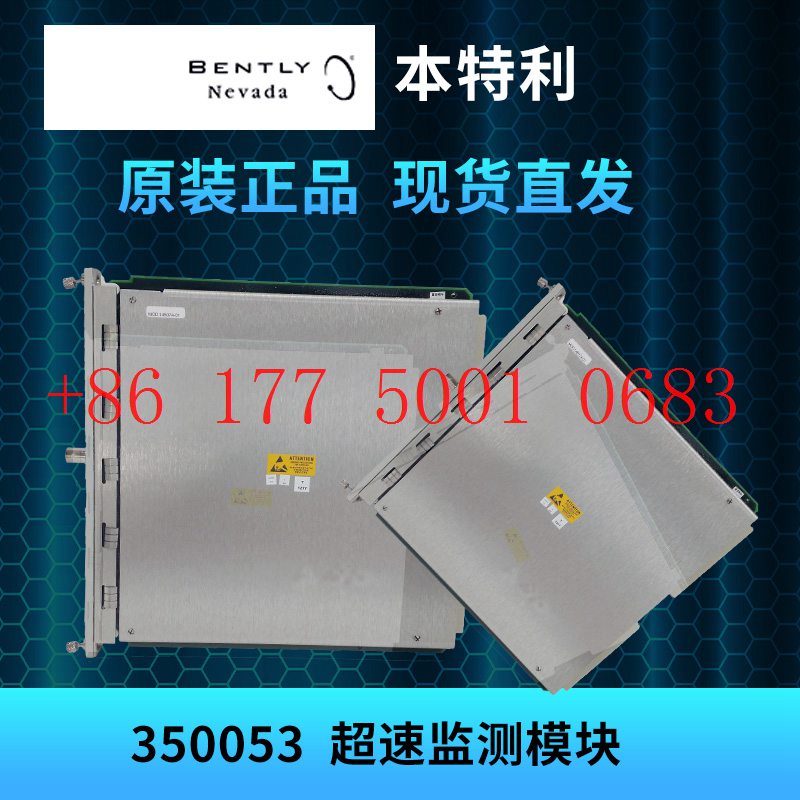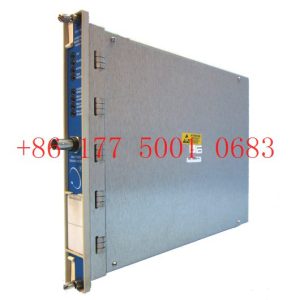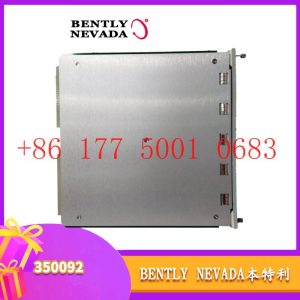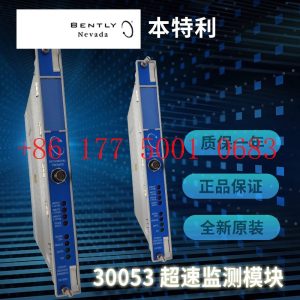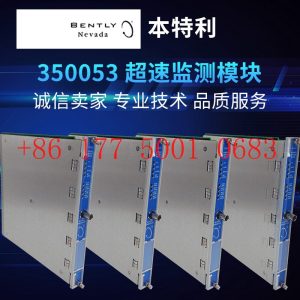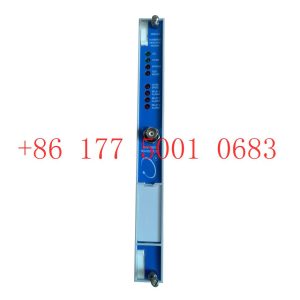Description
3500/33-01-00 Transient Data Interface BENTLY
3500/33-01-00 Transient Data Interface BENTLY
Module Clips Drive controller servo moto
The 3500/33-01-00 EGD Communication Gateway Integrates process control and other automation systems using both Ethernet TCP/IP and serial (RS232 / RS422 / RS485) communications capabilities. Permits Ethernet communications with 3500 Rack Configuration Software. The 3500/33-01-00 also supports proprietary Bently Nevada protocol along with Modicon Modbus and Modbus/TCP protocols.
3500/33-01-00Communication Gateway integrates easily with process control networks and other automation systems using both Ethernet TCP/IP and serial (RS232 / RS422 / RS485) communications capabilities. Permits communications via Modbus using 3500 Rack Configuration Software. The 3500/33-01-00 can be configured using the 3500 Rack Configuration software to produce a custom or condensed Modbus map for communications using fixed or configurable registers. All vital rack information including direct vibration, gap, 1X, 2X, Smax, channel statuses, rack status, trip multiply, rack reset, and others can be easily communicated.
Contact: Mr. Lai
Wechat:17750010683
Whats app:+86 17750010683
Skype:+86 17750010683
QQ: 3221366881
3221366881@qq.com
How giants brought the robotics industry up
Affected by the trend of China’s manufacturing transformation and upgrading, the “machine substitution” craze has arrived. Since 2013, China’s industrial robot market has begun to develop rapidly. Judging from the purchase volume of robots, China has become the world’s largest application market.
However, more than half of the dividends generated by China’s huge market have been captured by the “four major families” of robots (Japan’s Yaskawa Electric, FANUC, Germany’s KUKA, and Switzerland’s ABB).
According to Zhiyan Information, China’s industrial robot market is dominated by foreign brands, and the “four major families” accounted for 57% of the domestic market in 2017. In the field of high-end industrial robots, the share of the four major families of multi-jointed robots with six axes or above is 95%, the share of the four major families in the automotive industry with concentrated downstream high-end applications is 90%, and the share in the welding field is 84 % .
It can be seen that the oligopoly competition pattern in the high-end field has basically been established. Correspondingly, the market share of domestic robots still needs to be improved. For independent brands to catch up with foreign brands, there is still a long way to go in terms of core technology and user services.
On the other hand, the development of the “four major families” of robots to this day is world-renowned, which is inseparable from decades of intensive cultivation. The growth path behind them is worth learning and exploring by domestic ontology manufacturers.
1. Build unique advantages with core technologies
For robot manufacturing, the four major families firmly grasp the key technologies of core components.
Especially when it comes to servo motors, Japan’s Yaskawa Electric Co., Ltd., which is dominated by servo drives, cannot be avoided. In the process of Yaskawa Electric’s development and growth, this critical step is inseparable, and it is also a pioneering work in the field of motors – the development of the world’s first DC servo motor Minertia .
As the company that developed the world’s first servo motor, Yaskawa Electric, founded in 1915, has been leading the trend with ultra-high-speed, ultra-precision motion control technology for many years.
The biggest advantage of its robot is its high stability, which can still maintain normal operation even under overload conditions. Therefore, Yaskawa Electric is very popular in heavy-load application fields such as the automotive industry.
Combining market demand with concentration and investment in technology is the key to Yaskawa Electric achieving major breakthroughs. The development of servo motors is based on the urgent need to improve production efficiency by major Japanese manufacturers.
At that time, the motor took a long time to start and stop, which made it impossible to further improve production efficiency. Undoubtedly, if this technical difficulty can be solved, huge market potential will be released.
Yaskawa Electric keenly captures this market pain point and concentrates on research and development here. However, success does not come overnight. In the early stages of technological breakthroughs, there will always be countless experimental failures.
Fortunately, hard work paid off. With the advantages of advance layout and technology accumulation, Yaskawa Electric was able to achieve this major innovation – Mitsuyuki Fukuda, an engineer at Yaskawa Electric at the time, used the method of attaching coils to the rotor surface. , to reduce the rotor diameter and control the motor ‘s moment of inertia to a minimum. It is understood that the response speed of this motor was almost 100 times that of ordinary motors at the time, which made Yaskawa Electric widely welcomed by the market.
Of course, this landmark technological leap did not stop Yaskawa Electric. Since then, Yaskawa Electric has continued to polish its own technology with the spirit of craftsmanship, and has continued to innovate in order to develop products that better meet user needs. Every technological breakthrough means leading the entire industry to progress.
According to reports, in 2018 (March-November), Yaskawa achieved revenue of 361.3 billion yen, a year-on-year increase of 6.3%. As of September 2015, the cumulative number of robots sold by Yaskawa Electric has exceeded 280,000 units, becoming the global robot sales champion.
Similarly, FANUC, known as the “Microsoft of robotics”, its founder Seiemon Inaba is also very convinced of the power of technology. He believes that continuous experimentation and innovation through mistakes are the key to FANUC. A creed that has always been there.
In order to stay ahead of its peers in technology, Inaba established a basic development research institute and a commodity research institute respectively. The former is mainly responsible for the products that the market will need in five or ten years; the latter is responsible for establishing commercialization goals and delivering results within one year. FANUC is always aware of crises, and the team atmosphere in its research institute is always full of fighting atmosphere.
The most prominent competitive advantage of its industrial robots is its extremely high precision. It is reported that the repeated positioning accuracy of Fanuc’s multi-functional six-axis small robot can reach plus or minus 0.02mm. Therefore, the market is very popular in light-load, high-precision applications.
MMII-PD-1-2-240 | GE | Multilin MCC controller
MMII-PD-1-2-120 | GE | Multilin Display motor protection system
PMA323BE | ABB | PMA323BE HIEE300308R1 Control board module
PPA322B HIEE300016R2 HIEE400235R1 Control board module
UAC389AE02 | ABB |UAC389AE02 HIEE300888R0002 Control board module
CP451-50 | Yokogawa | CP451-50 processor module
GRBTU | ABB | GRBTU 3BSE013175R1 ABB Base
3BSE005461R1 | ABB | DSPC174 3BSE005461R1 Processor board
DSPC 174 | ABB | DSPC174 3BSE005461R1 Processor board
7DI140.70 | B&R |7DI140.70 Digital input module
7AO352.70 | B&R |7AO352.70 analog output module
7AI261.7 | B&R | 7AI261.7 Analog input module
IOP114 | METSO | IOP114 Input module
1747-L553/A | AB | 1747-L553/A SLC 5/05 processor
1747-L552/A | ABB |1747-L552/A SLC 5/05 processor
216AB61 | ABB | 216AB61 HESG324013R100 Output module
216EA61b | ABB |216EA61b HESG324015R1 Output module
PFEA112-65 | ABB | PFEA112-65 3BSE050091R65 tension electronic sensor
216NG63 | ABB | 216NG63 HESG441635R1 Output module
F404002A | STEIN| F404002A VISTA bus interface module
PM866AK01 | ABB | PM866K01 3BSE050198R1 Processor unit
3500/42M 176449-02 | BENTLY | 3500/42M 176449-02 Preprocessor/seismic monitor
REU615E_D | ABB | REU615E_D voltage protection measurement and control device
2713P-T12WD | Alleny-Bradle | 2713P-T12WD1 Analog resistance touch screen
5069-AENTR | Allen-Bradley | 5069-AENTR Compact 5000 Ethernet communication adapter
SPIET800 | ABB | SPIET800 Ethernet CIU transmission module
PR9376/010-021 | EPRO | PR9376/010-021 Speed sensor
PR 9376/010-01 | EPRO | Speed sensor PR9376/010-01
PR9376/010-001 | EPRO | PR9376/010-001 Speed sensor
PR9350/12 | EPRO | PR9350/12 Thermal expansion sensor
PR9350/08 | EPRO | PR9350/08 Thermal expansion sensor
PR9350/06 | EPRO | PR9350/06 Thermal expansion sensor
PR9350/04 | EPRO | PR9350/04 Thermal expansion sensor
PR9350/02 | EPRO | PR9350/02 Thermal expansion sensor
PR9350/01 | EPRO | PR9350/01 Thermal expansion sensor
MMS 6772 | EPRO | MMS6772 Dual current module
MMS 6771 | EPRO | MMS6771 Shaft vibration monitoring panel
MMS 3910/410-01 | EPRO | MMS3910/410-01 Dual current module
MMS 3910/311-32 | EPRO | MMS3910/311-32 Dual current module
MMS 3910/311-16 | EPRO | MMS3910/311-16 Rotational speed redundant module
MMS 3910/311-08 | EPRO | MMS3910/311-08 Dual current module
MMS 3910/311-04 | EPRO | MMS3910/311-04 Rotational speed redundant module
MMS3910/311-01 | EPRO | Speed direction module MMS3910/311-01
MMS3910/311-02 | EPRO | MMS3910/311-02 Limiting latching module
MMS 3311 | EPRO | MMS3311 speed transmitter
MMS 6822 | EPRO | MMS6822 Communication board
MMS 6831 | EPRO | Communication board MMS6831
MMS 6418 | EPRO | MMS6418 expansion monitoring board
MMS 6410 | EPRO | MMS6410 expansion monitoring board
MMS 6312 | EPRO | MMS6312 speed monitoring board
MMS 6310 | EPRO | MMS6310 Key phase monitoring board
1.Has been engaged in industrial control industry for a long time, with a large number of inventories.
2.Industry leading, price advantage, quality assurance
3.Diversified models and products, and all kinds of rare and discontinued products
4.15 days free replacement for quality problems
ABB — AC 800M controller, Bailey, PM866 controller, IGCT silicon controlled 5SHY 3BHB01 3BHE00 3HNA00 DSQC series
BENTLY — 3500 system/proximitor, front and rear card, sensor, probe, cable 3500/20 3500/61 3500/05-01-02-00-001 3500/40M 176449-01 3500/22M 138607-01
Emerson — modbus card, power panel, controller, power supply, base, power module, switch 1C31,5X00, CE400, A6500-UM, SE3008,1B300,1X00,
EPRO — PR6423 PR6424 PR6425 PR6426 PR9376 PR9268 Data acquisition module, probe, speed sensor, vibration sensor
FOXBORO — FCP270 FCP280 FCM10EF FBM207 P0914TD CP40B FBI10E FBM02 FBM202 FBM207B P0400HE Thermal resistance input/output module, power module, communication module, cable, controller, switch
GE —- IS200/215/220/230/420 DS200/215 IC693/695/697/698 VMICPCI VMIVME 369-HI-R-M-0-0-E 469 module, air switch, I/O module, display, CPU module, power module, converter, CPU board, Ethernet module, integrated protection device, power module, gas turbine card
HIMA — F3 AIO 8/4 01 F3231 F8627X Z7116 F8621A 984862160 F3236 F6217 F7553 DI module, processor module, AI card, pulse encoder
Honeywell — Secure digital output card, program module, analog input card, CPU module, FIM card
MOOG — D136-001-007 Servo valve, controller, module
NI — SCXI-1100 PCI – PXIE – PCIE – SBRIO – CFP-AO-210 USB-6525 Information Acquisition Card, PXI Module, Card
Westinghouse — RTD thermal resistance input module, AI/AO/DI/DO module, power module, control module, base module
Woodward — 9907-164 5466-258 8200-1300 9907-149 9907-838 EASYGEN-3500-5/P2 8440-2145 Regulator, module, controller, governor
YOKOGAWA – Servo module, control cabinet node unit
Main products:
PLC, DCS, CPU module, communication module, input/output module (AI/AO/DI/DO), power module, silicon controlled module, terminal module, PXI module, servo drive, servo motor, industrial display screen, industrial keyboard, controller, encoder, regulator, sensor, I/O board, counting board, optical fiber interface board, acquisition card, gas turbine card, FIM card and other automatic spare parts


